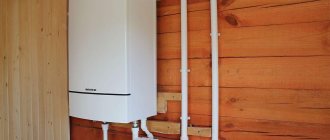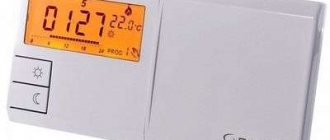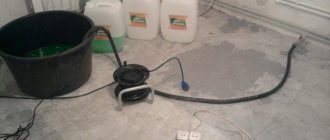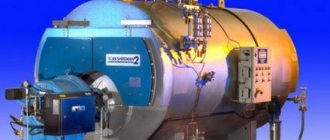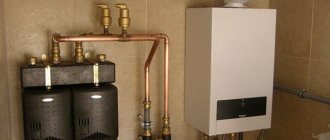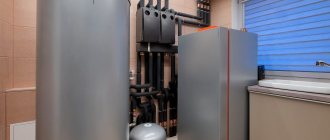Manual and automatic adjustment of room temperature from modern heating sources is carried out using thermostats or thermostats.
They are mechanical and electronic. Each of them has its own pros and cons.
Among electronic models, three types are most widespread:
- thermostat for water heating
- for electric underfloor heating
- for gas boilers or boilers
In appearance, they are all very similar to each other, but their circuitry is different.
Let's take a closer look at the features of connecting a thermostat to a gas boiler, its diagram, errors and possible problems when operating such devices.
Energy management
- Purpose of thermostats for heating boilers
- Types of thermostats for heating boilers
- Thermostat for a heating boiler (thermostat): which one is better to choose
- The principle of operation of a mechanical thermostat for a heating boiler
- Advantages of electronic wireless thermostats for gas boilers
- Functions of room thermostats for gas boilers
- Connection diagram of the thermostat to the heating boiler
- Heating control using a thermostat for a gas boiler
- Setting up a thermostat (temperature controller) for a heating boiler
- Thermostats for electric heating boilers: how to choose a device
- Where to buy thermostats for heating boilers
Purpose of thermostats for heating boilers
To be able to control the energy consumption of heating equipment, it is equipped with special devices - thermostats. These devices allow efficient use of fuel by shutting off the equipment when the set temperature level is reached. Thermostats are used for electric boilers, gas and solid fuel boilers, as well as convectors, heaters and other heating systems.
To achieve economical operation of the heating boiler, the thermostat turns on the equipment when the temperature drops below the set value and turns off when the set value is reached. This method allows you to avoid unnecessary consumption of gas or electricity when, for example, some of the rooms are located on the sunny side and less heat is needed to heat them than for other rooms.
Helpful advice! Even a slight decrease in temperature within 1 degree helps reduce energy consumption by 4-6%.
In addition, using thermostats, you can set the operating mode of the heating system, in which the temperature in the absence of people in the house or at night will be 4-5°C lower. Thanks to this, it is possible to achieve savings in electricity or gas consumption of about 30%. Thus, if your heating equipment does not have such a built-in device, it would be advisable to buy a thermostat for the heating boiler. The temperature regulator will provide a solution to the problem of excessive energy consumption.
Types of thermostats for heating boilers
Equipping heating equipment with thermostats allows you to maintain a given temperature climate in the room with an accuracy of 1 to 0.5 degrees. They control the operation of the heating system using various actuators. There are electromechanical and electronic thermostats. The design of a mechanical thermostat for a heating boiler has an on/off key and a rotary button for controlling the temperature regime.
Electronic or programmable thermostats have a more advanced structure, but are simple and easy to use. With their help, you can adjust the daily temperature cycle: in this case, the boiler will automatically switch to the set mode. Such devices can regulate both the entire heating system and individual heating blocks.
There is a classification of devices into wired and remote controlled. For the former, the connection of conductors, as well as external protection from mechanical damage, is important. The quality of the signal supplied from the boiler to the controller, notifying the entry of coolant into the circuit, depends on this. During installation, the question may arise about how to disguise the signal line so that it is invisible.
In a wireless boiler thermostat, control occurs through the transmission of a radio signal. Such a device has two blocks, one of which is mounted in close proximity to the heating boiler, connecting to the equipment terminals. The second node is located indoors. There is a dedicated radio communication channel between the two blocks. The control unit is equipped with a display and control keyboard.
Depending on the degree of automation, thermostats can be digital or analog. The operation of digital devices is based on the signal of microcircuits, thanks to which the device can record and apply several specified modes. Analog thermostats are controlled manually using a mechanical regulator connected to a rheostat.
Thermostat for a heating boiler (thermostat): which one is better to choose
Before buying a thermostat for a boiler, you need to decide on the type of device. To do this, you need to understand the fundamental difference between the models of mechanical room thermostats and electronic ones. There is an opinion that the latter are difficult to configure and they are unreliable, but this is not the case.
The principle of operation of a mechanical thermostat for a heating boiler In most cases, mechanical thermostats for a heating boiler are used in gas installations. This is due to the fact that gas boiler manufacturers initially produce devices that are compatible specifically with mechanical models of thermostats. The design of a mechanical thermostat has a gas membrane, inside of which there is a special gas.
When the temperature deviates from the norm, the volume of gas inside the membrane changes and the mechanism for closing or opening the power supply system of the heating boiler is activated accordingly. This is a fairly simple way to control the operation of a boiler, when its operation depends on the temperature not of the coolant, but of the air in the heated room.
Using a mechanical model of a thermostat, you can set an acceptable temperature regime by turning the round button with divisions, which is connected to the membrane. Thus, the walls of the membrane approach or move away from the control device: this is how we set the temperature at which the connection or rupture of the contact will occur.
Helpful advice! The simple design of mechanical thermostats for heating boilers allows you to make the device yourself.
Among mechanical devices, Siemens room thermostats have proven themselves well. Models RAA21, RAA31 have a temperature setting range of 8-30°C. Devices with a laconic design are mounted like ordinary switches and do not violate the integrity of the interior line. Easy to install and operate. The approximate price of a room thermostat for a gas boiler is 1,500 rubles.
The advantages of mechanical thermostats include low cost, repairability and resistance to power surges. The disadvantages include the low sensitivity of the device to temperature changes. Inaccuracy may be up to 3°C.
Advantages of electronic wireless thermostats for gas boilers
The use of programmable wireless thermostats for gas boilers makes it possible not only to control the operation of heating devices, but also to do this remotely. Electronic regulation allows you to set different operating modes of the boiler depending not only on temperature, but also on a certain time of day.
By purchasing a wireless thermostat for a gas boiler with programmable functions, you can count on significant fuel savings. The purchase of a relatively expensive device pays for itself within two heating seasons.
Modern models of thermostats are equipped with the GSM standard, which allows you to transfer information to a mobile phone via SMS messages. Considering the fact that boilers from leading manufacturers support Wi-Fi technology, and their electronic control unit is connected to a thermostat, it is possible to configure the operation of heating equipment via the Internet. Know-how in this area is the development of special applications for smartphones.
A convenient operating system, no need for wires, and automatic control of equipment are important advantages in using a wireless room thermostat for a gas boiler. You can buy devices with additional options, such as joint control of the gas burner unit, adjustment of equipment depending on the outside temperature, system diagnostics and other functions.
Among the disadvantages of programmable room thermostats, one can highlight, perhaps, the possible incompatibility of the latter with boilers, depending on their manufacturer. This problem arose due to the large number of manufacturers of electronic equipment and gas heating equipment.
Top 4 rating according to KP
Terneo RK 32A (average price 3000 rubles)
Terneo RK 32A.
Photo: yandex.market.ru A relatively rare form factor for thermostats is implemented in the Terneo RK 32A. The device is intended for installation in electrical panels or, as it is also called, on a DIN rail. The device works with heated floors and boilers. The control here is electronic and is carried out using three buttons. But the temperature set for the boiler is visible on a very simple three-digit screen. But its readability is quite good thanks to brightness and contrast. By the way, with the help of RK 32A you can also control the heating of pipes, protecting them from freezing. This model has no remote access or programming, so the boiler can only be controlled manually.
Advantages and disadvantages
Installation in an electrical panel will be useful for someone; it works not only with boilers, but can also be used in a pipe heating system.
No programming possible.
show more
Caleo C450 (average price 1800 rubles)
Caleo C450.
Photo: yandex.market.ru An affordable heat regulator option for a warm home. The design of Caleo C450 involves surface-mounted installation. The range of adjustment of the boiler heating degree here is from 10 °C to 35 °C. The controls of this model are mechanical, but with their own specifics. It is clear that they tried to save money here, but why is there no temperature gradation around the twister, but only risks? Probably, the manufacturer was trying to save money this way. But there are two temperature sensors and a self-diagnosis mode.
Advantages and disadvantages
Inexpensive, moisture-proof
You will have to guess with the temperature when setting, narrow adjustment range for the boiler
show more
Nest Learning Thermostat 3.0 (average price 22 thousand rubles)
Nest Learning Thermostat 3.0.
Photo: yandex.market.ru A thermostat capable of working with heating boilers, which is quite indecently expensive. The functionality here is so broad that some options seem superfluous. Externally, the thermostat is a washer that is installed separately. The connection between the device and the boiler is wireless, via Wi-Fi, so Nest needs to be selected for certain models of heating equipment. You can control the regulator using a rotary ring or from a mobile application. Of course, both mode programming and remote control are present here. Unusual features include automatic shutdown if people leave the room; creating an auto-schedule based on user preferences; auto start when a person appears in the room. With the latter, a problem may arise, or rather, with the operation of the sensor - therefore the manufacturer recommends not installing the thermostat for the boiler in the far corner.
Advantages and disadvantages
An interesting solution for a “smart home” that may appeal to geeks, extensive automation
Not suitable for all heating boilers, huge cost - for this price you can buy several excellent thermostats from other manufacturers
show more
REXANT R200 (average price 2411 rubles)
REXANT R200.
Photo: yandex.market.ru A relatively affordable option for a thermostat for a boiler. Despite this, a large touch display is used here. The device is installed discreetly, in the frame of the light switch. R200 can work with both underfloor heating and an electric heating boiler, as well as infrared elements. The device measures the temperature in the room with two sensors: internal and external. There is also programming of up to 6 time periods for each day of the week. The manufacturer declared a function when the thermostat realizes that the temperature in the system is higher than the set one, after which the heating stops. It’s interesting that even though IP20 protection against dust and moisture is claimed here, users complain that the device is still afraid of water ingress. There are also defects when the device breaks down literally after six months.
Advantages and disadvantages
Touch control, dual-zone metering
Moisture protection is only on paper, there are defects
show more
The best choice
The selection of a thermostat for a heating boiler is based on the personal preferences of the room owners. When choosing, you should consider what characteristics are required when using a particular boiler.
Wired or Wireless
The communication between the control unit and the sensors and the boiler for different models is carried out wired or wirelessly. In the first case, you will need to lay a wire. The cable length reaches 20 m. This allows the control unit to be mounted at a great distance from the room in which the boiler room is installed.
Wireless thermostats for heating boilers are designed as a receiver and transmitter. A distinctive feature of products of this type is that there is no need for wiring. The transmitter signal can be received at a distance of 20-30 m. This allows you to install the control panel in any room.
Temperature setting accuracy
Depending on the design of the room thermostat, the room temperature setting differs. Inexpensive models have mechanical control. The disadvantage of cheap thermostats is the error reaches 4 degrees. In this case, the temperature adjustment step is one degree. Products with electronic control have an error of 0.5 - 0.8 degrees and an adjustment step of 0.5o. This design allows you to accurately set the required power of the boiler equipment and maintain the temperature in the room in a certain range.
Ability to set the hysteresis value
The room thermostat for a gas boiler has a difference between the switch-on and switch-off temperatures. It is necessary to maintain optimal heat levels in the room.
Hystersis principle
For mechanical products, the hysteresis value does not change and is one degree. This means that after switching off, the boiler will start working after the air temperature in the room drops by one degree. Electromechanical and electronic models have the ability to set hysteresis. The adjustment allows you to change the value up to 0.1 degrees. Thanks to this design, it is possible to constantly maintain the room temperature in the desired range.
Programmable
The function is only available for electronic or electromechanical thermostats. It is possible to program the control unit to set the temperature according to the clock. Depending on the model, thermostats are programmed for up to 7 days. This makes it possible to make the heating system with the gas boiler turned on autonomous. At a certain time, the thermostat turns on or off the boiler unit or changes the intensity of its operation. With weekly programming, gas consumption can be reduced by up to 30 percent.
Wi-fi or GSM
Thermostats with built-in wi-fi and gsm module connect to the internet. Gadgets with installed applications are used to control heating. This is how remote shutdown, connection of the boiler and adjustment of temperature indicators in the heated room are carried out. Using the GSM standard, the room thermostat transmits information about the occurrence of malfunctions in the heating system to the owner’s phone. It is possible to remotely turn on or off the gas boiler.
Safety
When choosing a thermostat for gas boiler equipment, you should pay attention to the presence of safety systems. Functions are available to prevent the circulation pump from stopping, protect against freezing or exceeding the maximum temperature in the heating system, etc. The presence of such options allows you to safely use boiler equipment in autonomous mode.
What temperature should I set?
The logic of work here is as follows. In factory settings, the boiler heats water according to the coolant temperature.
By installing an external thermostat, we thereby give it a command to heat the water not as the boiler wants, but according to the settings of the thermostat, i.e. to a certain temperature in a particular room.
With normal insulation of the house and minimal heat loss, a gas boiler with a thermostat will operate for only 3-4 hours per day.
If the thermostat after installation did not affect the operating time of the boiler in any way, then most likely the temperature on the gas appliance is set lower than necessary. The regulator sensor simply does not have time to warm up to the desired value and operate, while the temperature of the coolant has already reached the specified threshold.
The instructions separately specify the minimum temperature on the boiler when using an external thermostat. As a rule, it should be at least 65 degrees.
Initially, it is recommended to set the design temperature on the heating device, which completely covers the heat loss of the building. When these heat losses are not known, values from 60 to 70C are taken for a standard heating system.
If you live in a relatively warm climate, and in winter you do not raise the temperature in the batteries above 45C, you will still have to increase it to work with the thermostat.
Some people wonder, what is the point of installing a regulator and how does this lead to savings?
There is nothing to worry about because the temperature will be higher:
- firstly, the boiler cycles less, warms up the system faster
- secondly, at a higher coolant temperature, the heat in the rooms lasts longer
- and the maximum efficiency of batteries is observed precisely at t 65C-70C, and not at +45C
We achieve maximum stability and comfort
An additional feature of many electronic thermostats is the ability to organize weather-dependent control, when the boiler power is adjusted, including changes in the outside temperature. To do this, just connect a universal outdoor temperature sensor to the thermostat (2-2.5 thousand rubles).
External temperature sensor for Gira thermostat 130200.
It consists of a single structure: a sensor and a wire 2-6 m long. Therefore, it is enough just to fix the wire strands in the corresponding contacts of the thermostat, according to the instructions.
Remote thermostats and choosing a location for their installation
A significant advantage in favor of electronic models can be the presence of remote thermostats. In this case, adjustment occurs using a separate panel, which can be placed in any place convenient for you. The choice of location for a remote thermostat in any building should be guided by safety and comfort parameters. It is better to place the thermostat out of the reach of children; it is also worth considering factors that can damage the device.
Currently, electronic thermostats with a Wi-FI module are also produced. Data from thermostats can be transferred directly to your smartphone using special applications created by developers. Using such applications, you can adjust the temperature remotely. Such models will fit perfectly into the “smart home” system.
Connecting the thermostat to the boiler: instructions
To obtain accurate measurement results, it is important to choose the right installation location:
- Installation near windows, entrance doors, ventilation ducts, climate control equipment and other objects that can affect the air temperature at the installation site is not recommended;
- It is not recommended to install it too high, near the ceiling, or too low to the floor, since heated air masses are concentrated near the ceiling, and in the absence of a heated floor, the temperature in the lower plane of the room is noticeably lower. The optimal installation height is 1.5 meters from the floor level;
- Installation near moving objects or objects that create mechanical shocks (doors, furniture touching the wall) is not recommended;
Also note that for loads above 10 A, the device is not connected directly, but through a modular contactor.
The connection and installation algorithm is always specified in the instructions for the device. For example, let's look at how to install a mechanical Cewal RQ-10:
| Photo | Process description |
| Remove the temperature control rotator | |
| Having removed the front panel, unscrew the corresponding screws | |
| We mount the structure on the wall through the appropriate holes specified in the instructions. | |
| According to the diagram from the instructions, connect the contacts. For the Cewal RQ-10 model, this diagram is shown in the photo. | |
| Additionally. There may be a jumper between the “TA” contacts of the board of some boilers; it must be replaced with a two-core insulated cable with a conductor cross-section of 0.5-0.75 mm2. |
Most modern thermostats are powered by AA batteries, but if power from the mains is required, its organization diagram looks like this:
All modern models of thermostats are supplied with instructions with a detailed, schematic description of the installation, connection and configuration algorithm. However, this requires basic electrical skills in any case.
Where and where to connect the wires on a gas boiler?
To connect the thermostat from the boiler terminal block to the Dry Contact contacts, you need to connect two conductors.
According to the instructions, the recommended cross-section of copper conductors is at least 0.75 mm2.
The cable length to the thermostat installation site should not exceed 50 meters.
Look for the necessary terminals on the boiler itself in the manufacturer's instructions, or refer to the inscriptions on the terminals.
These terminals are most often located on the back of the control board.
However, sometimes manufacturers take them outside the board.
During installation, some installers also connect the cable here and take it out, so that the consumer does not later go to the board and mess up something. Since the thermostat has not yet been installed, the ends of the cable are short-circuited.
By the way, be careful with this remote pad. Some consumers have encountered the problem of factory wires being mixed up, such as with Protherm.
As a result, everything started to work as it should, only when connected back.
Initially, there is a jumper between the terminals. If the jumper is broken, the gas boiler will simply stop working.
When connecting the thermostat, the factory jumper is removed and a cable laid to the installation site of the thermostat is installed in its place. The most important thing is that you don’t need to change any internal settings on the boiler.
A low voltage control pulse (usually 24V) is supplied through these contacts.
We have a control device (thermostat) and a slave (boiler). Between them, a set of requests and responses is constantly transmitted over a low-current line.
The principle of operation here is simple - by closing the dry contact, we thereby allow the operation of the boiler, by opening it, we interrupt the data transfer and prohibit it. Closing and opening occurs through the thermostat relay, depending on the set temperature on the device and comparison of the current readings in the room.
When triggered, the burner is first switched off, then after a certain period (pump run-on time) the circulation pump is switched off. Although the pump operation algorithm may differ in different models.
One of the algorithm options
It is not advisable for the pump to turn off immediately after the thermostat is activated. In this case, set the run-on time from 5 to 10 minutes in the menu. Then the entire heating system will cool evenly and the time intervals for automatic operation will increase.
On expensive models that support the OpenTherm protocol, through a remote programmer you can control many built-in parameters of the boiler, and not just turn it on and off.
Here are clear examples of where to connect the thermostat for different boiler models:
BaxiBoschElectroluxVaillantJunkersBuderusViessmanFerroliAtronAlfa CalorImmergas
What happens if the thermostat fails? How will the boiler behave in this case?
It all depends on the position in which the dry contact remains. If it is closed, nothing bad will happen. The boiler will simply start operating according to its last set program.
If it is open, the heating will not start and will not work.
Please note that the thermostat does not affect the operation of the burner in hot water supply mode.
A voltage of 220V is supplied to the power contacts of the thermostat - phase and zero (L and N). This can be done either from a separate outlet or junction box, or taken directly from the boiler itself.
On a regulator with dry contacts, it makes no difference where the phase or zero is connected, but on models for electric underfloor heating this plays a significant role in the issue of operational safety.
Since if the connection is incorrect, only the neutral conductor will break, and the phase will be constantly on duty on the heating cable.
Connection diagrams
All methods of connecting a thermostat to a heating system are divided into three connection options:
- Directly to the boiler.
- To the circulation pump.
- On the pipe supplying coolant to the radiator.
The first two schemes eliminate the deterioration in the throughput of the heating pipeline. No additional locks are placed in it, and the hydraulic resistance of the entire system does not change. The thermostat here only controls the operation of the pump or boiler; it “does not come into contact” with water.
When installing a thermostat on a battery or a common pipe with several radiators, the hydraulic resistance, on the contrary, increases. Even when fully open, the thermostat valve slightly slows down the flow of coolant.
Ideally, the boiler piping project should be carried out immediately, taking into account all thermostatic and other devices.
Thermostats should only be installed into existing heating pipelines as a last resort; maximum efficiency from their use can only be achieved if they are included in the system at the design stage
If the water heating system in the house is made according to a single-pipe scheme, then it is better to immediately abandon the third option. When the temperature sensor is triggered, the valve will immediately shut off the entire radiator line in several rooms, and then you can immediately forget about comfort in rooms far from the boiler.
The thermostat should be connected to the radiator input via a bypass. So, when triggered, it will redirect the coolant flow bypassing the battery. In this case, the water will return uncooled back to the boiler. The latter will stop heating it, thereby reducing the consumption of gas fuel or electricity.
When installing a thermostat air temperature sensor, you must adhere to certain rules, otherwise, under the influence of neighboring devices or objects, it will trigger falsely.
The temperature sensor must be mounted:
- in a place where there is no direct sunlight;
- away from cold bridges, drafts and rising heat flows from radiators;
- so that it is not covered by decorative screens or curtains;
- at a height from the floor within 1.2–1.5 meters.
If the sensor is installed incorrectly, the thermostat will produce false signals. This can lead to overheating not only of the air in the room, but also of the coolant in the system. And in the second case, it won’t be long before there are problems with the boiler.
How does a heating thermostat work?
A conventional heating system with water as a coolant consists of heating equipment or a connection point to a centralized network, internal wiring pipes and radiators.
To regulate the volume of heat coming from it into the rooms, you have to either constantly monitor the boiler or regularly close/open the valves on the radiators.
At the same time, the inertia of such a system does not allow maintaining the desired temperature throughout the day at the set level. If you put more firewood into the stove or supply gas to the boiler, the coolant in the pipes will heat up more, and it will also release more heat through the radiators.
This is good at low temperatures outside. But with sudden warming outside, the heat in the house becomes unbearable. The fuel is already in the firebox, and the water has already heated up, there is no way to get rid of the heat. Plus the boiler continues to work.
Without a thermostat in the system, you have to turn it off manually. You can, of course, open the windows for ventilation and let out the heat, but then the fuel bills for your home boiler room will definitely ruin you. The conclusion suggests itself: a heating thermostat simplifies living and makes it as comfortable as possible.
A thermostat (temperature regulator) is a device for monitoring the temperature in a heated room and increasing/decreasing the heat supply to it
The thermostat for the heating system consists of:
- temperature-sensitive sensor (element);
- tuning unit;
- control module;
- electromagnetic relay or mechanical valve.
In the simplest models there is no control unit. Everything happens due to pure mechanics and changes in the physical properties of the temperature-sensitive element.
These thermostats do not require power supply. In terms of efficiency and accuracy of system adjustment, they are inferior to electronic devices, but they are non-volatile. If there are problems with the voltage in the network, they will definitely not stop working.
The operating principle of the thermostat is as follows:
- Using the control unit, the desired temperature is set.
- When the required parameters are reached, the sensor is triggered, which leads to the boiler turning off or the shut-off valve in the heating pipes closing.
- After the air temperature in the room drops, the boiler equipment or heaters turn back on.
The electronic control module allows you to set not just one temperature indicator, but several for each time of day separately. Plus, if such a unit is available, it is possible to install an additional temperature sensor outside and link the functioning of the thermostat to the data from it.
Depending on the type of device, the thermostat is connected directly to the boiler to regulate its operation or at the inlet to the radiator to control the volume of coolant supply
The simplest thermostat is a shut-off valve with a temperature sensor, located on a pipe near the battery. When the desired temperature is reached, the thermostatic valve closes and reduces the coolant flow. And when the room air cools, it opens again, resulting in an increase in the volume of incoming heat.
More complex and advanced models require wireless sensors and control units. All communication between individual elements occurs through a radio channel. In this case, wires are not laid, which has a positive effect on the aesthetic side of placing such thermostats in the room.
Programmable room thermostat
A programmable electronic room thermostat allows you to select the desired and comfortable temperature at any time; it is easy to reconfigure and change the operating mode. The timer allows you to set a different heating pattern on weekdays and weekends. Some timers allow you to set different settings for each day of the week, which can be useful for people who work part-time or shift work. Many Terneo and KChM models are equipped with such thermostats.
Programmable room thermostat
A programmable room thermostat allows you to set individual heating standards for each day in accordance with your lifestyle and maintain the temperature of the house all the time, regardless of the presence or departure of the owners. Video: Connecting a room thermostat to a gas boiler
If the heating system is controlled by a boiler with a radiator, as a rule, only one programmable room thermostat is needed to control the entire house. Some patterns need to be adjusted in the spring and fall as the clocks move forward and backward or certain changes in climatic conditions occur. We also recommend changing the temperature settings when changing from day to night.
This climate controller has several options that expand its capabilities:
- “Party”, which stops heating for several hours, then resumes;
- “Override” allows you to temporarily change the programmed temperatures during one of the configured periods;
- “Holiday” increases the heating intensity or reduces it for a certain number of days.
Review of manufacturers
Oventrop (Germany) is considered the leader. They have a large selection of wall and desktop units with LCD displays and more options. There are reliable models with mechanical control.
Universal room thermostats with wide programming capabilities are produced by the German factory Watts. They allow you to set night and day modes, as well as control all thermostats in the house from one point. Timers offer several options for factory and custom settings.
Mechanical contact thermostats are produced by the Italian brand Emmeti.
Central thermostat
This thermostat is located far away from your boiler and usually allows you to turn the heating on or off throughout the house. Older versions are connected by wires to the boiler; newer systems tend to send signals to the device's command post. It is the new type of devices that are equipped with quite expensive but effective appliances: double-circuit boilers Ferroli, Beretta and domestic AOGV.
The most famous are room thermostats for double-circuit boilers of the Gsm and Protherm brands. They have a built-in dilatometric thermostat for the boiler, which, depending on the model, can operate remotely; this technology is often used for an electric boiler or solid fuel units.
The room thermostat turns off the heating of the system as needed. It works by measuring the air temperature, turning on the heating when the air temperature drops below the thermostat setting, and turning it off when the set temperature is reached.
Adviсe:
- It is recommended to set the thermostat to 20°C;
- At night, the set temperature should be between 19-21° C.
- It is advisable that the temperature in the children's room is about 22 ° C.
- The temperature should not fall below 22°C in rooms for elderly and disabled people.
As a rule, the temperature of the entire house or individual rooms is based on only one climate microcontroller in the heating system. The best option is to place it in the living room or bedroom, which should probably be the most visited place in the house.
Room thermostats need free air flow to measure temperature, so they should not be covered with curtains or blocked by furniture. Devices adjacent to the electric thermostat may interfere with the correct operation of the device. These include lamps, TVs, neighbors' boilers through the wall, touch switches.
What is it needed for?
Even modern gas boilers of domestic and foreign production, as a rule, have the simplest system for regulating the level of heating of the coolant. The user sets the temperature parameters using a mechanical or electronic regulator.
The sensor monitors the heating of the liquid in the heating system and sends signals to turn off or turn on the gas supply. The main feature of such a device is its lack of efficiency, which is explained by the lack of taking into account the air temperature inside the heated room.
Installation work on installing a remote-type room thermostat for a gas boiler will become relevant if it is necessary to ensure the most accurate temperature control. Installing a special sensor indoors can reduce fuel costs by about 16-20%.
Homemade external thermostat for the boiler: instructions
Below is a diagram of a homemade thermostat for a boiler, which is assembled using Atmega-8 and 566 series microcircuits, a liquid crystal display, a photocell and several temperature sensors. The Atmega-8 programmable microcircuit is responsible for compliance with the specified parameters of the thermostat settings.
Scheme of a homemade external thermostat for a boiler
Strictly speaking, this circuit turns the heating boiler on or off when the outside air temperature decreases (increases) (sensor U2), and also performs these actions when the temperature in the room changes (sensor U1). It is possible to adjust the operation of two timers, which allow you to adjust the time of these processes. A piece of circuitry with a photoresistor affects the process of turning on the boiler depending on the time of day.
Sensor U1 is located directly in the room, and sensor U2 is located on the street. It is connected to the boiler and installed next to it. If necessary, you can add an electrical part of the circuit that allows you to turn on and off high-power units:
The electrical part of the circuit allows you to turn on and off high-power units
Another thermostat circuit with one control parameter based on the K561LA7 chip:
Thermostat circuit with one control parameter based on the K561LA7 microcircuit
The thermostat is assembled on the basis of the K651LA7 microcircuit and is simple and easy to adjust. Our thermostat is a special thermistor that significantly reduces resistance when heating. This resistor is connected to the electricity voltage divider network. This circuit also contains resistor R2, with which we can set the required temperature. Based on this scheme, you can make a thermostat for any boiler: Baxi, Ariston, Evp, Don.
Another circuit for a microcontroller-based thermostat:
Circuit diagram for a thermostat based on a microcontroller
The device is assembled on the basis of a PIC16F84A microcontroller. The role of the sensor is performed by a digital thermometer DS18B20. A small relay controls the load. Microswitches set the temperature, which is displayed on the indicators. Before assembly, you will need to program the microcontroller. First, erase everything from the chip and then reprogram it, and then reassemble it and use it to your health. The device is not capricious and works fine.
The cost of parts is 300-400 rubles. A similar regulator model costs five times more.
A few final tips:
- although different thermostat options are suitable for most models, it is still desirable that the thermostat for the boiler and the boiler itself be made by the same manufacturer, this will greatly simplify the installation and operation process itself;
- before purchasing such equipment, you need to calculate the area of the room and the required temperature in order to avoid “downtime” of equipment and changes in wiring due to connecting devices of higher power;
- before installing the equipment, you need to take care of the thermal insulation of the room, otherwise high heat losses will be inevitable, and this is an additional cost item;
- if you are not sure that you need to purchase expensive equipment, then you can conduct a consumer experiment. Buy a cheaper mechanical thermostat, adjust it and see the result.
Electric boilers
A fairly common alternative to gas and solid fuel boilers. Lots of advantages, high efficiency, but long payback period. The connection is simple, like with gas boilers, but without a cold water supply. Temperature regulation and overheat protection are provided.
Mechanical boiler timer
Using a simple mechanical timer for an electric boiler, there are three options for starting the central heating system :
- The boiler is turned off;
- The boiler supplies warm water;
- The boiler turns on and off at the set time.
Mechanical timers usually have a large round dial with a 24-hour scale in the center. By turning the dial, you can set the desired time, and then leave it in that position. The boiler will turn on at the right time. The outer part consists of a set of tabs for a 15-minute period, which are inserted for easy adjustment of operation and mode settings. Emergency reconfiguration is possible, which is performed with the boiler connected to the network.
Mechanical timers are easy to set up, but the boiler always turns on and off at the same time every day, and this may not satisfy the owners if the family is large and bathing procedures are carried out several times a day at different times.
About compatibility issues
The method of connecting the thermostat to the boiler is largely determined by the choice of thermostat model and can be done either from a controller, from a battery, or from a network.
You can often find recommendations from boiler manufacturers; when purchasing a simple or programmable thermostat for a gas boiler, rely on the boiler manufacturer and its recommendations. In principle, this advice is worth listening to, although, having looked through the pages of numerous forums where issues of connecting climate control equipment are discussed, you can often come across the opinion that for the most part, products from different brands “get along” well without entering into conflict.
But the parameter that is really worth considering when deciding to buy a temperature sensor for a heating boiler in a regular HVAC or household appliances store or online store is the area of the room heated by the boiler and the most preferred temperature regime.
Main types and features of thermostats
Based on the technology of transmitting a signal from a room temperature sensor to the control unit, the thermostats in question are either wired or wireless. In the first case, the thermostat is connected to the gas boiler by wires laid throughout the cottage. The second option is a separate module next to the water heater and temperature sensors in the rooms of the house, transmitting information to the control device via a radio channel.
Model with RS communication TECH ST-280, price about 12,000 rubles
In terms of functionality, the thermostat can be:
Simple (mechanical) - designed only to maintain a given room temperature.
Programmable - allows you to set modes for different times of the day and each day of the week.
With additional humidity sensor.
Mechanical version of Baxi RAA20 from SIEMENS, price about 2600 rubles
The choice of a specific model depends on the configuration of the heating system and the wishes of the home owner regarding the level of microclimate control in the home. But the more functions and capabilities a device has, the more expensive it is. It is often most profitable to choose the simplest, most reliable and inexpensive option.
Programmable version Jung TRUDME231AT, price about 30,000 rubles
Conclusion on the topic
The use of room temperature regulators allows you to create the most comfortable conditions for staying in the premises and operating heating equipment, and significantly save money by reducing gas consumption. The temperature sensor installed in the room reacts sensitively to all changes, increasing or decreasing the heat supply, sending a signal to the heater controller.
However, you should know that fuel savings are possible only after taking measures aimed at reducing heat loss at home. Otherwise, consumption may increase, since the thermostat will not be able to stop the boiler until the air temperature set by the owner is reached.
Video on the topic:




